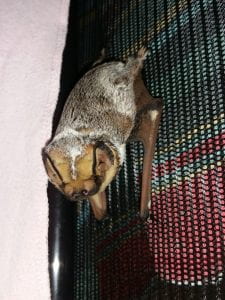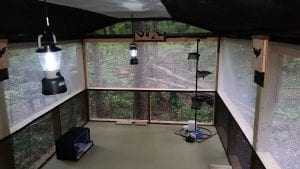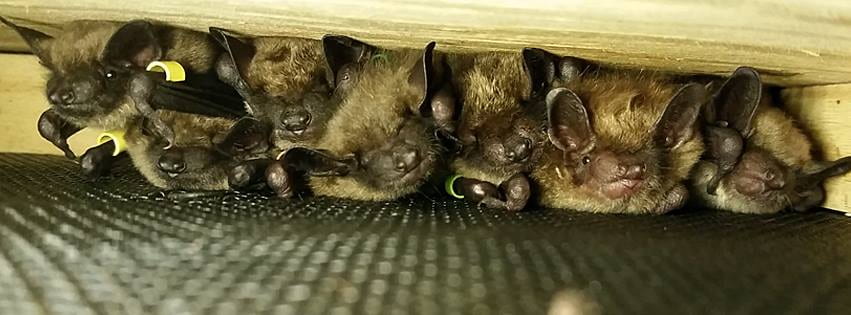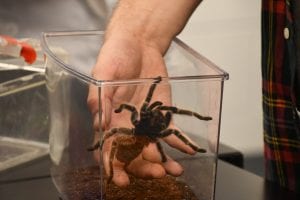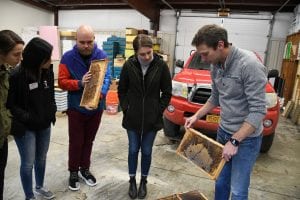When the average person thinks of a bat, many thoughts may cross their mind, most of them negative. These thoughts and feelings include fear, disgust, and more. People often think of them as “flying rats”, worry that all bats will drink their blood, or try to attack them. In fact, out of over 1,300 bat species, there are only three species of vampire bats that drink blood, while the vast majority of other species are insectivores or frugivores, meaning they eat insects or fruit and nectar. Bats are responsible for an incredible amount of insect control, improving public health by keeping the numbers of disease-carrying bugs, like mosquitoes, down. They also protect crops from insects, eliminating the need for massive amounts of pesticides. Frugivorous bats are important pollinators and seed dispensers, keeping plants and forests healthy. Other people have a fear of rabid bats, and while this can be a concern, just like any other mammal that can be a rabies vector, the vast majority of bats are rabies-free. Like many wild animals, bats are usually more scared of humans than we are of them.
I’ve learned all of this and more volunteering at Wild Things Sanctuary in Ithaca, NY, working with a variety of local bat species. Some of these species include Little brown bats, Big brown bats, Eastern red bats, and Hoary bats. While I wasn’t one to be disgusted or afraid of bats, I was definitely a little wary the first time I had to grab one out of its cage at Wild Things. Victoria Campbell, the founder, was patient as she instructed me and other volunteers on handling techniques. The majority of the bats that come in are Big brown bats, and even the largest of these can still fit in the palm of your hand. It’s hard to interact so closely with them and not eventually fall in love.
In the outdoor flight cage at Wild Things, bats are able to fly around, catching insects that make their way in, or eating the mealworms provided until they are strong enough to be released. If you visit the flight cage around dusk, you can sometimes see bats flying across, swerving around your head as their echolocation guides them through the enclosure. Sometimes, we turn on the bat monitor to hear the clicks of their echolocation as the bats go about their lives.
When the weather turns and the harsh Ithaca cold sets in, any bats that are not able to be released at that time are brought inside to be overwintered until the spring or summer when it is warm enough for them again. Many of these bats may hibernate much of the winter away in a room that is kept cold enough to allow them to sleep, much like the caves that these bats would inhabit naturally in the winter. Other bats are kept in heated cages to allow them to heal from injuries or to maintain their metabolism if they require treatments like antibiotics or pain medication. Bats are brought to Wild Things from all over the state. Oftentimes, Victoria will rely on the help of volunteers or other rehabilitators to bring bats part or all the way from more distant locations.
Victoria Campbell is solely responsible for the care of the bats, and with the help of the occasional volunteer like myself, can take in and rehabilitate over one hundred bats in a year. This number could be even higher if bats were less misunderstood and people were as willing to help them as they were a baby bird or an injured squirrel.
More than learning about bat species, husbandry, or fun facts I can throw out at a cocktail party, the biggest lesson I have learned working with these animals is just how misunderstood they are. They are not the blood-sucking flying terrors that many make them out to be. They have different personalities and rich social interactions with each other. Sometimes while treating them, they can be very vocal or try to fly away, but you can tell how scared they are to be injured in some unknown environment being handled by a large creature for an unknown reason.
Bats in the Northeast are increasingly threatened by white-nose syndrome. White-nose is a fungus that can grow on hibernating bats in caves and lead to their deaths. It is thought to do this by irritating bats enough to wake them up during hibernation, leading to them burning through their fat stores faster so they are unable to survive through the winter. It can also damage their wings, making flight impossible. Entire populations of bats in some areas have been wiped out by the fungus. In a time when we are facing great threats to wildlife both at home and globally, there is no better time to show some compassion to bats and other equally “undesirable” species. In the end, it benefits both those animals and you!
To learn more about Wild Things Sanctuary and the work they do, visit their website: http://www.wildthingssanctuary.org/


